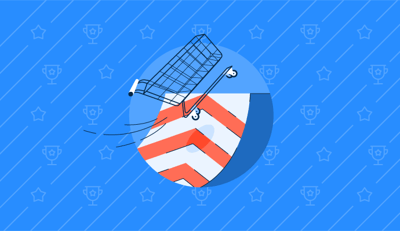December 6, 2022
 by Téa Liarokapi / December 6, 2022
by Téa Liarokapi / December 6, 2022

Decoding the retail puzzle for businesses.
From consumables to clothing to electronics to upholstery, everything is available online. We can open any e-commerce application, sift through available inventory, pick out what we need, and add it to the cart. But how? It's not just retail; omnichannel retail that drives today's market force.
Omnichannel retail is a unified business communication, and operational strategy ensuring a brand's product reaches the customer at a specific time. It includes different delivery options, supply chain techniques, dropshipping, and marketing automation, to name a few.
Contextualizing the buyer's experience throughout their purchase journey with omnichannel commerce software nurtures them in a better, more relatable way.
Let's now understand the roadblocks ahead of a successful omnichannel retail strategy.
Challenges of omnichannel retail include synchronizing customer purchase orders, supply chain management, and order fulfillment. These challenges also occur as businesses take a one-dimensional marketing approach, resulting in poor consumer engagement.
History of the omnichannel retail strategy
Today, most well-known retailers started their digital journey with a single channel. They needed a proper framework to attribute lead sources and prioritize consumers. Further, their logistics, distribution, and supply chain also worked in silos. Unaware of what was coming next, most of their prospects shifted their interest to a competitor brand. They shifted because they needed a brand to seep through their requirements with a better product.No matter how simple the "single-channel" outreach was, the brands had to revamp it ultimately. And so, the concept of "multichannel retail" was born, which enabled customers to pick their favorite traffic channel to engage with the brand. And on the flip side, enabled brands to understand consumers better. The brands also coined the idea of "round-the-clock" availability, where they touch base as soon as customers initiated an action.
The only problem with the multichannel strategy was that it needed to provide a central repository to handle consumer data. Whatever the consumer purchased, be it through a website, social media, or storefront, couldn't be tracked correctly. This lack of information further impeded demand forecast, which resulted in poor inventory timelines. The problem needed an immediate fix, and that fix was omnichannel retail.
In 2003, Best Buy made a move that revolutionized retail forever with an "omnichannel retail strategy." It also unified all its customer service efforts into one system. This framework was based on omnichannel communication and lean manufacturing, which promoted end-to-end retail funnel management.
As the customer puts items in the cart, a purchase order (PO) gets triggered in the Best Buy system, which alerts the vendor and supplier. The consumer receives a computed ETD (estimated delivery time) while the backend supply chain works on the manufacturing. Customers could collect the finished item from the retail store on the due date. No muss, no fuss.
If customers are dissatisfied with their orders, the omnichannel retail strategy captures their concerns via brand messaging. Customers could either escalate the matter or call the helpdesk to initiate a specific resolution.
As enticing as this practice may sound, it can be challenging. So, let's talk about these and how you can overcome challenges using simple tactics.
It's a fact that juggling all the "normal stuff" in a business – such as billing, staff, and inventory – can be stressful. So how can you draw a consumer graph to achieve retail standards?
You need to know which part of the sales funnel your customers are on, what they need and what makes them tick-with data.
Plus, you can't think that the only place to get data is your website cookies – seeing as customers don't get onto your website alone anymore. Centralize your data across different sources like website browsers, telephony email campaigns, chatbots, etc. have you and your prospect on the same page. You can use CRM software to do that.
Gather further customer insights, data-driven KPIs, and other clues and put them together to complete your GTM requirements.
Tip: Learn how to create the most engaging landing page copy to ensure your landing page is doing its job!
We're talking about a lot of data that needs to be segmented and grouped into categories. Once you do that, you'll know what each customer needs, what they've checked out, and how to lead them to an effortless and natural purchase.
While customer engagement is one of the most important things you could aim for, more is needed to ensure loyalty. Without loyalty, factoring in your brand success is a no-go.
Consumers expect businesses to have a personalized approach. For this, we've got to thank audio streaming platforms like Audible, Google Podcast, and OTT platforms like Amazon Prime and Netflix. Why does personalization work? Let's see.
Consider you are a vegan brand that needs to promote almond milk for its consumers. if you sent an ad or an article portraying the benefits of almond milk to someone who likes skim milk, you'd miss the mark. Consumers who prefer skim milk for coffee will not engage with you if you do not understand their intent. You must customize your audience requirements and add customer reviews and references to ensure your voice is heard.
Once you can capture, segment, and remarket old data, you can build effective buyer personas for prospects under your radar. You can creatively use this information to build custom Google and Facebook audiences and widen ad engagement. When prospects come across something that strikes their hearts, they are bound to engage.
Once you have the desire in place, it's time to re-engage them and nurture engagement.
This goes for all omnichannel retailers: Understand your customers' behavior first, then customize.
Provide a seamless experience where nobody will have to do more than tap on an icon to get connected (no friction, no entering passwords) and keep the menu they'll need to use clean and tidy.
With a separate section – the offers section – get the incentives going for every single step they complete (data, referrals, downloading your app, etc.). Send them an email each time you have something new to offer, personalize it as per their preference and notify them.
Offering additional offers, discounts, and early birds in your promotional campaigns can also sprinkle that extra magic of personalization.
3. Conflicts between the various channels
A proper demand planning strategy can stabilize your inventory planning. As internal stakeholders, you must gather necessary touchpoints, bolster supplier ties and entice market demand. If you can predict inventory requirements in real-time, you can surpass any retail challenge.
An inventory management system also ensures that every channel, production, supply chain, or transportation works in tandem. Analyze your inventory carrying costs, tracking, order fulfillment, perfect order %, and cycle inventory from the ideal location to get a better idea of who is working on what.
Through cross-departmental collaboration, the marketing team will be able to come up with offers, the finance team will know the quotes, and the sales team will know exactly how many people it can sell the special offers to.
You need to get yourself in front of people. Couple your content with intent data, digital properties, and product insights to drive value. Regardless of the size of your business, develop a content marketing strategy that is people-driven rather than business-driven.
Bring your content together with your tech stack in an orchestrated motion. Whether you're working on flyers, display ads, eBooks, or decks, punch in the opinion of your peers from different departments.
Departments like analytics, market research, sales, product, and consumer success have a fair idea of your ideal customer. You can also catch old communication chats or trails. Treat your customer as a friend you want to help, not an egg you want to hatch.
5. Failure to track user intent
Ignoring actionable user data stored via website cookies, impressions, registrations, and other consumer actions can weaken your resolve. Customer data becomes obsolete soon as they change their IP addresses, internet connections, and phone numbers. Further, if the lead data is stored in point solutions and buried deep in your organizational repository, no communication plan can take off.
Get a bird's eye view of your customer insights, learn market trends, and check deal closure reports to refine your go-to-market strategy. It is very beneficial to overview customer profiling and co-relate it from the marketing perspective. Ensure you collate everything on your network so sales and marketing teams can collaborate.
A CMO Council and RedPoint Global survey revealed that marketers need to know how to use user data to craft engagement strategies. It also said that despite some marketers being up-to-speed with the latest tools and techniques, a more significant chunk of them still need to be connected to it. Failure to use a particular software or tool can impeach your sales growth as you might not be able to capture buyer intent from all angles.
Investing in employee upskilling is the best way to solve these burning issues. Upskilling has a bundle of benefits, like helping your employees learn the ropes of newer, trendier software. Upskilling converts great people into great executives. Sure, hiring a top-tier graduate may seem like the best option, but in the long run, it's the experience that matters.
3 common omnichannel retail examples
You can get some much-needed inspiration and understand what you need to do with the help of three retail brands. These brands were so good with omnichannel that nobody else could do it the way they did – maybe you can!
Timberland is one of those retailers that leveled the retail field with cutting-edge tech.
They could check what their customer touched or viewed through mobile devices and in-store gadgets. They use digital signage, visual cues, and "TouchWalls" that show only online inventory to consumers.
This allows Timberland to gather data and put products in the spotlight, ultimately creating and mapping out a customer journey that will lead to endless product suggestions and repeat business.
2. Sephora
Beauty brands like Sephora are marquee names for omnichannel experiences. This brand provides users with a complete, unique, and unified experience.
You can start from the app – that captures your geolocation. By radio-tracking all the nearest Sephora outlets in the area, it curates the best in-store deals and coupons. Sephora is betting on the latest tech to connect with consumers. The stores are packed with augmented reality marketing devices where clients can "try on" various products without messing with the samples and themselves (no friction).
Don't worry about the dreaded "We're out of stock" warning. Sephora is never out of stock. The brand can order the product for you, and you can choose whether you'll have it shipped or pick it up from the store.
In addition, the Sephora Black Card uses a unique point system to give offers and discounts, customized product suggestions, and a trusted warranty. Plus, the brand gets top levels of loyalty and customer satisfaction!
Talk about incentivizing engagement! Steve Madden is a retailer that focuses on footwear and has made a profit from having customers engage with it using its uniquely-made and well-thought-of point system: The SM PASS.
By signing up, you automatically get free two-day shipping on orders over $50, five points for each $1 you spend, more points for referrals, curated offers, and access to "secret products."
Connect your social media, and you'll get extra points. Enter your data for even more points. The company loves it, as it gets more insight into what customers want, allowing it to send curated emails and specific product recommendations that customers won't pass up!
Omnichannel commerce software brings all your engagement efforts to a central place by automating contextual workflows. This platform integrates with any existing ERP, like e-commerce platforms, customer relationship management (CRM) software, retail management systems, or email marketing software, to create webhooks and connect communication lines. Since the software manages both online and in-store experiences, it is widely used by retailers.
To be included in the omnichannel commerce software category, a product must :
Shopify Plus is an e-commerce and reselling brand that caters to high-volume enterprises and scales marketing goals with social media marketing.
"I love the ability to track orders, discounts, and customers. I love having visibility on all of our clientele who are ordering. With information, we can make decisions, plan for the future, analyze trends, and improve the business."
Shopify Plus review., Greg R.
"Going from $299 to $2000 is such an extreme jump we're planning on avoiding site customizations to limit the need for such high-level support for our second managed site."
Shopify Plus review., Andrew W.
PartnerLinQ is a secure supply chain cloud that connects your production unit, manufacturing unit, vendors, and suppliers. The platform contextualizes traditional inventory integrations and stabilizes the overall output of each process.
"Enhance B2C /B2B sophisticated online communication via EDI; Multiple branding thus increased sales, sales data analysis, reporting, data visualizations, partnership management. I crown its intrusive UI/UXD for its simplicity and pre-made custom templates (LMS), among others."
PartnerLinQ review., Andrew M.
"As a user, all the built-in features for this software are excellent and high quality with great features; the PartnerLinQ support team is responsive 24 hours a day, and there are no negative points in this fantastic platform."
PartnerLinQ review., Marzieh H.
BigCommerce is a leading SaaS-based service that empowers stakeholders across business departments to journal all their work online and create a motivational community.
"BigCommerce is the best platform that fits my business from every side. I like the dashboard of this platform and how easily I can upload and manage inventory. I am satisfied with the agility and speed that is protecting and growing the sales of my products. Without no limitations, I can control my eCommerce business. In a professional way."
BigCommerce review., Usman Y
"It could use a WYSIWYG update. Some of the items on the page builder needed to be styled through CSS. Also, the ability to create different layouts based on desktop or mobile would be great."
BigCommerce review., Josh F.
Fynd is India's largest cross-retail platform that reduces the current impact of challenges for your brand. It helps you automate your store operations and cross-sell and upsell products to increase retention.
"The full solution from backend to logistics made it feasible to launch our brand site without much of a team needed at our end."
Fynd review., Deepak M.
"Littlebit tech issue; However, SPOC person helps prioritize our customer issues in every scenario."
Fynd review., Vidhyadhar Y
The SAP Commerce cloud drives sales through digital marketing initiatives across different lead-generation platforms. With a growing base of 3500 customers, SAP Commerce Cloud has been used for transactions up to 570 billion dollars over 120 million orders.
"SAP Commerce Cloud Is a quick deployment billing tool which is a quick plug n play."
SAP Commerce Cloud review., Juned A.
"There are no disadvantages with SAP commerce cloud; the product has four main benefits of using SAP Commerce Cloud: it's omnichannel, provides a polished customer experience, comes with pre-loaded features, and enables teams to leverage a cloud-based infrastructure easily."
SAP Commerce Cloud review., Sireesha B.
Learn how to craft a successful sales strategy around buyer challenges to crack deals faster.
Téa Liarokapi is a Senior Content Writer for Moosend, an email marketing and marketing automation platform, and an obsessive writer in general. In her free time, she tries to find new ways to stuff more books in her bookcase and content ideas – and cats – to play with.
Placing orders on e-commerce websites has become too mainstream; every single shopping fanatic...
.png) by Shreya Mattoo
by Shreya Mattoo
The shifting purchase patterns of the global consumer base have made e-commerce necessary for...
 by Piper Thomson
by Piper Thomson
My journey in digital marketing began at an e-commerce agency. I worked closely with clients...
 by Bhoomika Pawar
by Bhoomika Pawar
Placing orders on e-commerce websites has become too mainstream; every single shopping fanatic...
.png) by Shreya Mattoo
by Shreya Mattoo
The shifting purchase patterns of the global consumer base have made e-commerce necessary for...
 by Piper Thomson
by Piper Thomson


